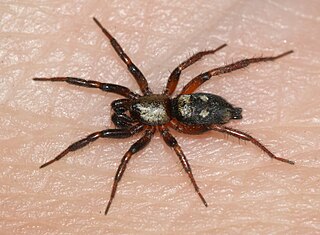
Uloboridae is a family of non-venomous spiders, known as cribellate orb weavers or hackled orb weavers. Their lack of venom glands is a secondarily evolved trait. Instead, they wrap their prey thoroughly in silk, cover it in regurgitated digestive enzymes, and then ingest the liquified body.

Lampshade spiders, family Hypochilidae, are among the most primitive of araneomorph spiders. There are two genera and twelve species currently recognized. Like mygalomorphs, most hypochilids have two pairs of book lungs, but like araneomorphs they have intersecting fangs, with the exception of some species which have chelicerae in an angle that is neither orthognathous or labidognathous. These long-legged spiders build typical "lampshade" style webs under overhangs and in caves. In the United States the fauna is primarily associated with the Appalachian, Rocky and California Mountains. Ten of the known species are found in these ranges, all in the genus Hypochilus. The genus Ectatosticta is found in China.

Metellina is a genus of tetragnathid spiders that occurs mostly in Eurasia, with two species found in North America. M. segmentata was introduced to Canada.

Callilepis is a genus of ground spiders first described by Niklas Westring in 1874. Some are found from Mexico to Canada, others from Europe to India. They are most commonly found in dry areas, sandy roads and beaches.

Hyptiotes is a genus of spiders in the family Uloboridae.

Hyptiotes paradoxus is a spider species with Palearctic distribution. It is notably found in Lithuania and Latvia. It is also found in Estonia and Finland.
Hyptiotes analis is a species of spider of the genus Hyptiotes. It is endemic to Sri Lanka.
Pseudanapis is a genus of araneomorph spiders in the family Anapidae, first described by Eugène Simon in 1905. It is a senior synonym of "Gossiblemma" and "Amrishoonops".
Leptoctenus is a genus of wandering spiders first described by L. Koch in 1878.
Willisus is a monotypic genus of North American araneomorph spiders in the family Cybaeidae containing the single species, Willisus gertschi. It was first described by V. D. Roth in 1981, and has only been found in United States.
Sergiolus gertschi is a species of ground spider in the family Gnaphosidae. It is found in the USA and Mexico.
Dolomedes gertschi is a species of nursery web spider in the family Pisauridae. It is found in the United States.

Castianeira gertschi, the Gertsch antmimic, is a species of true spider in the family Corinnidae. It is found in the United States and Canada.

Hypochilus gertschi, or Gertsch's lampshade-web spider, is a species of lampshade weaver in the family Hypochilidae. It is found in the United States.
Cesonia gertschi is a species of ground spider in the family Gnaphosidae. It is found in the United States and Mexico.
Hyptiotes puebla is a species of cribellate orb weaver in the family of spiders known as Uloboridae. It is found in the United States and Mexico.
Micaria gertschi is a species of ground spider in the family Gnaphosidae. It is found in the United States and Canada.

Atypoides gertschi is a species of folding-door spider in the family Antrodiaetidae. It is found in the United States.

Hyptiotes cavatus, the triangle weaver, is a species of cribellate orb weaver in the family of spiders known as Uloboridae. It is found in the United States and Canada. It uses an unusual hunting technique whereby it tightens up an anchor line of the web whilst waiting for prey. This effectively winds up and compresses the web. When prey touches the web, the spider releases the held anchor line, causing the web to spring forwards 2-3cm at high speed. This causes up to 4 additional web strands to touch the prey, and the sudden stop when the web reaches the end of its elasticity then winds the prey further into the strands. This process has analogues to the techniques by humans used to power catapults and ballistae.
Trechalea gertschi, the long-legged water spider, is a species of true spider in the family Trechaleidae. It is found in the United States and Mexico.











